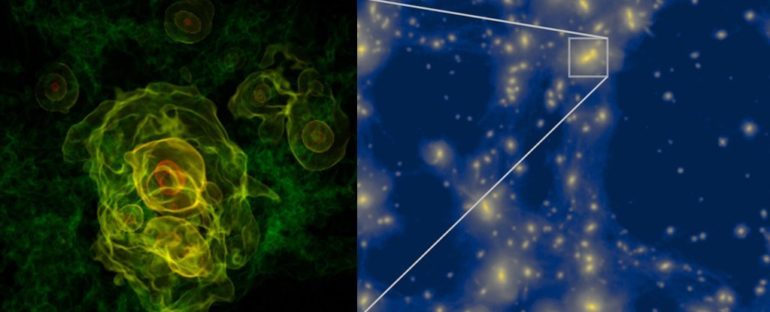Peer long enough into the heavens, and the Universe starts to resemble a city at night. Galaxies take on characteristics of streetlamps cluttering up neighborhoods of dark matter, linked by highways of gas that run along the shores of intergalactic nothingness.
This map of the Universe was preordained, laid out in the tiniest of shivers of quantum physics moments after the Big Bang launched into an expansion of space and time some 13.8 billion years ago.
Yet exactly what those fluctuations were, and how they set in motion the physics that would see atoms pool into the massive cosmic structures we see today is still far from clear.
A new mathematical analysis of the moments after a period called the inflationary epoch reveals that some kind of structure might have existed even within the seething quantum furnace that filled the infant Universe, and it could help us better understand its layout today.
Astrophysicists from the University of Göttingen in Germany and the University of Auckland in New Zealand used a mix of particle movement simulations and a kind of gravity/quantum modelling to predict how structures might form in the condensation of particles after inflation occurred.
The scale of this kind of modelling is a little mind-blowing. We’re talking about masses of up to 20 kilograms squeezed into a space barely 10-20 meters across, at a time when the Universe was just 10-24 seconds old.
“The physical space represented by our simulation would fit into a single proton a million times over,” says astrophysicist Jens Niemeyer from the University of Göttingen.
“It is probably the largest simulation of the smallest area of the Universe that has been carried out so far.”
Most of what we know about this early stage of the Universe’s existence is based on just this kind of mathematical sleuthing. The oldest light we can still see flickering through the Universe is the Cosmic Background Radiation (CMB), and the entire show had already been on the road for around 300,000 years by then.
But within that faint echo of ancient radiation there are some clues on what was going on.
The CMB’s light was emitted as basic particles combined into atoms out of the hot, dense soup of energy, in what’s known as the epoch of recombination.
A map of this background radiation across the sky shows our Universe already had some kind of structure by a few hundred thousand years of age. There were slightly cooler bits and slightly warmer bits which might nudge matter into areas that would eventually see stars ignite, galaxies spiral, and masses pool into the cosmic city we see today.
This poses a question.
The space making up our Universe is expanding, meaning the Universe must once have been a lot smaller. So it stands to reason that everything we see around us now was once crammed into a volume too confined for such warm and cool patches to emerge.
Like a cup of coffee in a furnace, there was no way for any part to cool down before it heated up again.
The inflationary period was proposed as a way to fix this problem. Within trillionths of a second of the Big Bang, our Universe jumped in size by an insane amount, essentially freezing any quantum-scale variations in place.
To say this happened in the blink of an eye would still not do it justice. It would have begun around 1036 seconds after the Big Bang, and ended by 1032 seconds. But it was long enough for space to snap into proportions that prevented small variations in temperature from smoothing out again.
The researchers’ calculations focus in on this brief instant after inflation, demonstrating how elementary particles congealing from the foam of quantum ripples at that time could have generated brief halos of matter dense enough to wrinkle spacetime itself.
“The formation of such structures, as well as their movements and interactions, must have generated a background noise of gravitational waves,” says University of Göttingen astrophysicist Benedikt Eggemeier, the study’s first author.
“With the help of our simulations, we can calculate the strength of this gravitational wave signal, which might be measurable in the future.”
In some cases, the intense masses of such objects could have pulled matter into primordial black holes, objects hypothesized to contribute to the mysterious pull of dark matter.
The fact the behavior of these structures mimics the large-scale clumping of our Universe today doesn’t necessarily mean it’s directly responsible for today’s distribution of stars, gas, and galaxies.
But the complex physics unfolding among those freshly baked particles might still be visible in the sky, among that rolling landscape of twinkling lights and dark voids we call the Universe.
This research was published in Physical Review D.



